Setting Folders and Filters (Message Rules) in By Dan W. Dooley WB5TKA
NOTE: These instructions apply to Outlook Express Only. Earlier versions of Outlook Express and Outlook 98/2000 will differ.
These initial paragraphs are not the procedures for setting up folders and filters within Outlook Express, but are necessary for setting the stage, so to speak. I'll get to the meat of the topic shortly. Bear with me.... Since it's hard to follow a sheet of instructions unless you can actually view the process as you go, you may want to print this out beforehand and launch Outlook Express to view the steps as you read.
Before we create new folders, let's make sure you can see the folders already present. To display the Folder List, go to menu View | Layout (Figure 1) and make sure that "Folder List" is checked. Checking too many items will clutter up the screen. For example, showing the Outlook Bar adds another column of icons actually duplicating those on the Folder List. The more columns on the screen, the less space there will be to view your messages. Likewise I'd suggest getting rid of the Folder Bar. That adds a gray line (bar) with the label of the folder you're currently in. That's more space wasted. I'd recommend these boxes be checked: "Folder List", "Status Bar", and "Toolbar". You could have if desired the "Contacts" box checked showing the contacts (names in your address book), but I'm not sure I see the value of that. The Address Book should be available from an icon on your toolbar.
Outlook Express 5
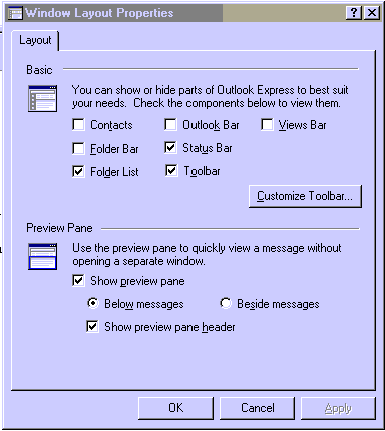
Figure 1
If you have your view set to show the Folders List in a vertical column on the left side, and as a result of checking the "Show preview pane" box, the "Below messages" radio button and the "Show preview pane header" box - all on the menu View | Layout dialog box - the listing of your received messages is in a horizontal window at the top, and preview of those messages is below that. This probably creates the cleanest, least cluttered screen (Figure 2).
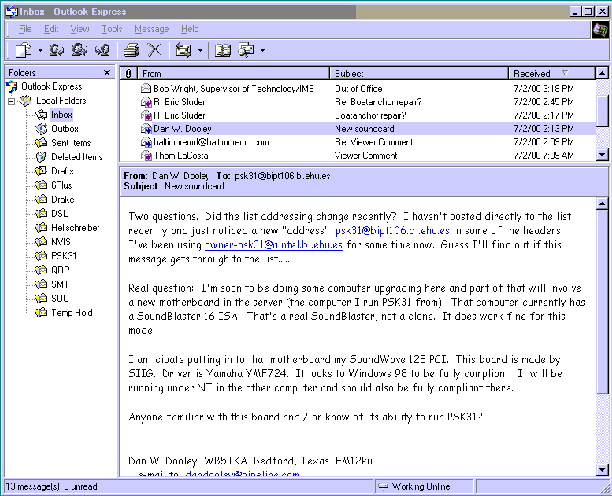
Figure 2
If you're looking at the Folders List in the left column, you will see a listing of folders similar to what you would see in the left pane of Windows Explorer. You've never seen that? Check it out some time.
So far, the layout is conducive to setting up subject folders and creating filters. One more thing. Go to menu Tools | Options. On the General tab, check the "When starting, go directly to my 'Inbox' folder". This insures that the default view of messages is your Inbox. This is of course where all default (unfiltered or un-redirected) messages appear.
To actually create a new folder, do the following:
- Highlight Local Folders in the Folders list.
- Right click the mouse and select from the resultant menu - "New Folder"
- Name it as desired. I've named folders for QRP, PSK31, SOC, etc. Once named, it will be added to the list of folders under Local Folders. Simple enough so far?
- Repeat this process until you have all of your needed folders created.
Now that the folders are created, let's create the rules to cause received messages to be routed to the proper folders.
- Go to menu Tools | Message Rules
- Select Mail from the popup menu.
- Make sure that the Mail Rules tab is up front (Figure 3).
- Click on the "New" button. Here (Figure 4) you will see four windows. The top window offers you several possible "conditions" for your rule. Such as: "Where the From line contains people", "Where the Subject line contains specific words", "Where the To line contains people", etc. The middle window offers you actions for your rule (what do you want to do with messages which fit the top window criteria?). The bottom window lets you define the conditions selected by the top window.
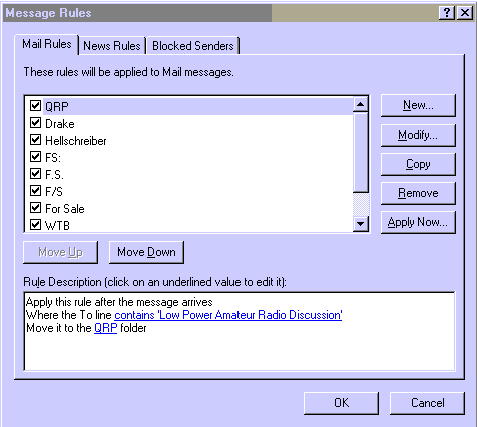
Figure 3
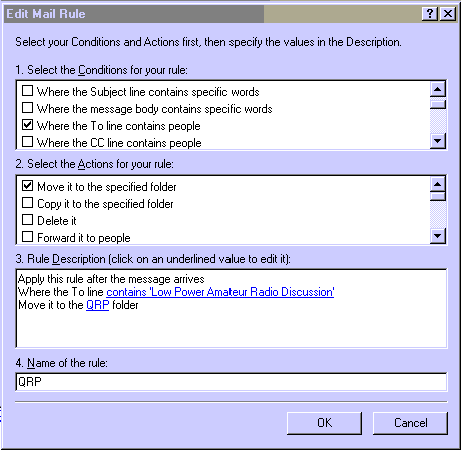
Figure 4
For example, when I set up a rule to filter all QRP related messages to my QRP folder, I selected in the top window the condition "Where the To line contains people." In the middle window, I selected to "Move it to the specified folder." In the bottom window, I clicked on the blue (on my computer) underlined "contains people", and entered in the top box on the next window that appeared the following: "Low Power Amateur Radio Discussion" - minus the quote marks, of course.
Then, I clicked the Add button, followed by the OK button. Now in the bottom window it says:
"Apply this rule after the message arrives
Where the To line contains 'Low Power Amateur Radio Discussion'
Move it to the specified folder"
The next step is to select the specified folder.
- Click on the underlined word "specified".
- Another window opens showing the folders under Outlook Express (Figure 5). If all of your folders do not display and there is a "+" in the small box before "Local Folders", click on the "+" to expand and show your previously created folders.
- Select the desired one and click on OK.
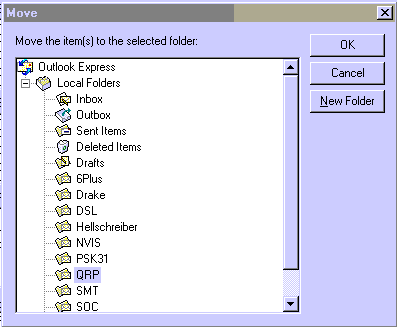
Figure 5
Oh yes, there is one more box on this window (Figure 4). At the very bottom and it's called "Name of the rule:" Here you can name the rule if you desire. It's optional, but probably a good idea to do so since once you close this window, you will be back to the original Message Rules window and all of your rules will be listed here. A meaningful name helps to identify what rule is what.
In some instances you may want Outlook Express to process your rules in a particular order. By clicking on either the Move Up or Move Down buttons in the Rules List screen (Figure 3), up can determine the order in which they are processed. This would be useful if multiple conditions exist and you wish the first condition to be satisfied before the second condition is evaluated. For example, if you created rules for "QRP-L For Sale", "QRP-L Contests", etc. and a final "QRP-L anything else". Clearly, if the "anything else" rule was first, the others would never be hit.
Let's create another rule. This time based on content in the Subject line of the message. Let's assume for the PSK31 list. Again, refer to the previous illustrations.
- Click on the New button.
- In the top window (1) check the box next to "Where the Subject line contains specific words."
- In window 2, check "Move it to the specified folder."
- Click on contains specific words in window 3.
- Type in the next box: "[PSK31]", again without the quotes.
- Click on Add and then OK.
- Click on specified.
- Just like in the previous example select the desired folder - in this case one created earlier called PSK31 and then click OK. If you find that you've created a rule and you have created no folder to send messages to which fit the rule, you can create a new folder while in step 8 above.
So, why did I use the format [PSK31] above rather than simply the word "PSK31"? This method specifies all messages coming from the PSK31 list. If you want to send all messages with the word PSK31 appearing anywhere in the Subject line, you can create a rule which will do so by eliminating the "[ ]". This rule would send any message containing that text in the Subject line into the PSK31 folder. You may want to create more than one rule to cover such needs. Many lists will prefix the Subject line with the name of the list enclosed in brackets.
The QRP list does not provide any list identification in the subject line. So, you must either use the method I outlined in the above example where the To line contains "Low Power Amateur Radio Discussion", or alternatively, "Where the From line contains people" and select the address book entry you have for the QRP list. Either method will work.
I have created rules to handle what I consider junk mail as well. Some of it is truly junk and some are messages dealing with topics that I'm not interested in and would rather not clutter my mailbox with. In the truly junk category, I created a rule to filter out messages with "International Drivers License" in the subject line, and another one for "Want to be a millionaire". These, I chose to "Delete from the server" as the Action. Additional rules to cover such Subject line content as: "FS:", "F.S.", "F/S", "For Sale", etc., cause such messages to be sent to the Deleted Items folder. There are a heck of a lot of items being offered for sale on the lists and also WTBs (Wanted To Buy), and though of interest to some, I'm not in a buying mode now, so have no reason to see them. That's the beauty of the filters. You can create them for just about any situation you want, and once created you can actually turn them off individually if you like. Turning a filter off does not eliminate it.
I hope that this document has at least pointed you in the right direction for creating and using message rules. You see, it is easy!
| Return to QRP | Comments for Dan |